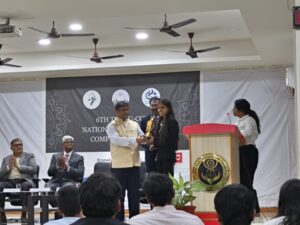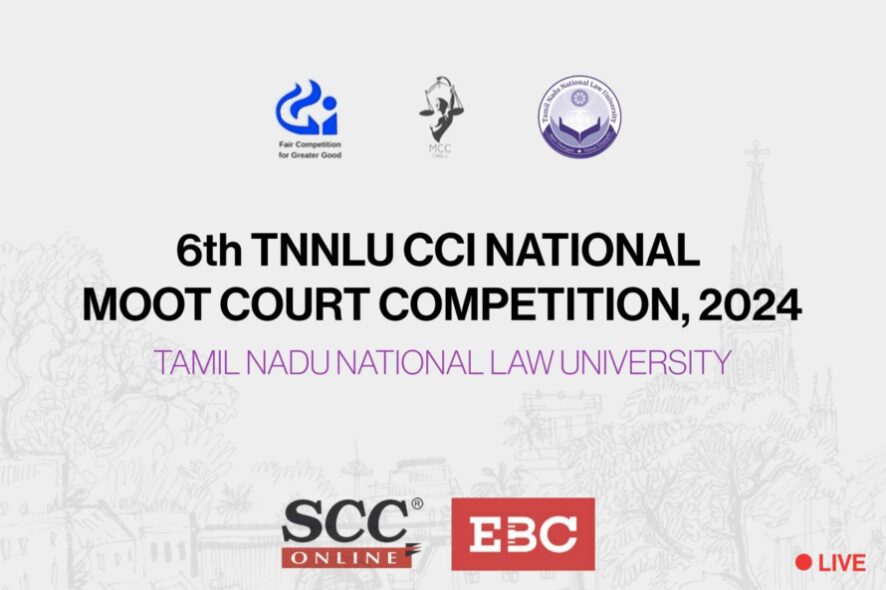Welcome to the Land of Cholas, Tiruchirappalli!
Here at TNNLU’s vibrant campus in Tiruchirappalli, Tamil Nadu, in collaboration with the esteemed Competition Commission of India (CCI) and Knowledge and Media Partners SCC Online and Eastern Book Company, we’re all set to witness three days of intense advocacy and legal brilliance.
This collaborative effort between TNNLU and CCI provides a unique platform for law students across the nation to immerse themselves in competition law, honing their advocacy skills and mastering the art of courtroom battles. It’s not just a competition; it’s a journey of learning, growth, and professional networking.
In this edition, TNNLU is hosting in total 24 teams from all around the nation. So, get ready to witness the future legal luminaries shine as they navigate the intricacies of competition law in this prestigious moot court competition.
Let the legal spectacle begin!
22nd March, 2024 (Day-1)
4:00 PM | Registration | UG Block
The event kicked off with registration, marking the beginning of an exciting gathering. Participants were warmly welcomed by the Organizing Committee, spreading positivity and encouragement. As registration wrapped up, it was clear that students from all over India had come together, ready to make the competition a success.
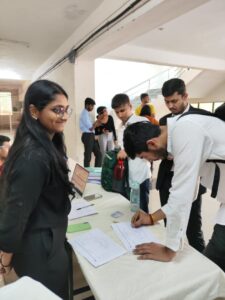
5:30 PM | Inaugratration Ceremony | UG Block
In the vibrant atmosphere of the 6th TNNLU-CCI Moot, where law intertwines with passion and Lady Justice presides with grace and fairness, participants were warmly welcomed by Ms. Niveditaa Raman, a distinguished member of the Moot Court Committee at TNNLU. With genuine enthusiasm, she extended a heartfelt welcome to all the teams representing various law schools. The ceremony was further dignified by the presence of esteemed guests, including Mr. Mahindra Prabu, the Dean of Undergraduate Studies at TNNLU, alongside Ms. Rajeshwari P. and Mr. V. Ravindran, both revered Faculty Incharges of the Moot Court Committee at TNNLU.
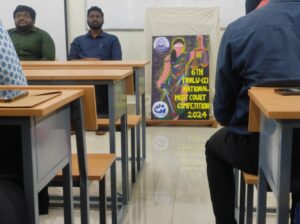
The ceremony commenced with an address from the UG Dean, Mr. Mahindra Prabu, who urged the gathered law students to recognize the burgeoning influence of Artificial Intelligence in the legal domain, particularly its interplay with the Competition Act. Following his insightful remarks, Mr. Prabu was honored by Ms. Rajeshwari, and in turn, he officially declared the competition open, marking the beginning of an exciting journey for all participants.
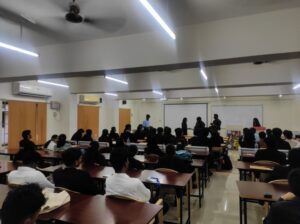
6:00 PM | SCC Online and EBC Reader Training Session | UG Block
Mr. Anish Mishra, Student ambassador for SCC Online and EBC Reader, commenced the SCC and EBC Orientation session by addressing the audience. He emphasized the significance of Mooting and proceeded to illustrate the functionalities and nuances of one of the paramount tools for Mooting – SCC Online. The session primarily delved into the functionality of EBC Reader and SCC Online.
Within the session, a spotlight was cast on the multitude of case laws accessible through SCC, making it a valuable resource for legal research. One noteworthy feature highlighted was the utility of Keywords, facilitating efficient search for relevant case laws. An example showcased the simplicity of using the “Type Word or Phrase” function to search for keywords, catering to both novice and seasoned mooters.
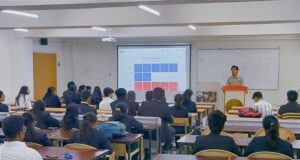
Two pivotal keywords, “Anti-Competitive agreement” and “Dominant Position,” were underscored during the session, this reference was taken from the Proposition of the 6th TNNLU-CCI National Moot Court Competition, 2024.
Furthermore, Mr. Mishra also emphasized on EBC Bare acts, and how they play a crucial role in understanding legal provisions, wherein each provision is elucidated along with essential case laws. Hyperlinks provided within the EBC reader seamlessly connect users to SCC Online for further exploration of relevant case laws.
Moreover, the “search within search” feature enables users to delve deeper into specific topics, while features such as Case Reference and automatic compendium preparation streamline the research process. Also, SCC Online offers diverse features like Find by topic, Find by Party, and Find by citation, enhancing the efficiency of legal research. The Curated Topics feature proves invaluable, enabling users to stay updated on significant developments and facilitating efficient moot court research. The session concluded with an overview of SCC Online and EBC Reader, empowering users with advanced filtration options for precise research outcomes.
7:00 PM | Researcher Test | PG Block
After the conclusion of the Inauguration and SCC Online and EBC Reader Training Session, the highly anticipated Researcher Test took place. This pivotal phase aimed to assess the depth of understanding and proficiency of the participants in the realm of competition law. Each researcher was allocated a duration of one hour to navigate through a comprehensive array of questions meticulously crafted to encompass both objective and subjective elements.
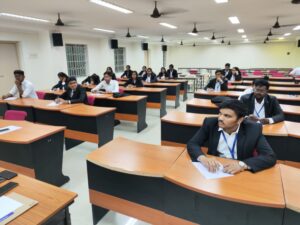
This marks the end of Day-1. Stay tuned for future updates!
23rd March 2024 (Day-2)
10:00 AM | Preliminary Round-I| UG and PG Block
Court Hall-I
The Counsel sought permission to address Issue 1, presenting arguments primarily focused on two main highlighted points due to time constraints. Following this, the judges requested relevant facts and precedents for the arguments presented by the Counsel, including excerpts of judgments mentioned in the memorandum.
Issue 2 was then addressed by the Counsel, referencing Section 3 of the Competition Act. During this discussion, judges raised queries regarding limitations on employee movement and their implications, which Counsel 1 addressed.
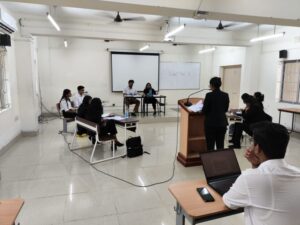
Further inquiries from the judges pertained to executive employment agreements and Section 3(3) of the Competition Act, particularly regarding the distinction between employers and employees in the service market, and the applicability of this provision. To address these queries, the Counsel transitioned to Issue 4. The judges requested substantial proof for the arguments presented, which the Counsel provided through case laws and advanced arguments.
Court Hall-II
The contention regarding the jurisdiction of the court was firmly asserted by the Counsel, emphasizing arbitration as the sole medium for issue resolution, citing a precedent to support this stance. Upon request, the Counsel referred to Compendium page number 50. Judges inquired about the questioning of the Sameer Agarwal case and requested justification. The Counsel defended, asserting that there’s no need for court intervention, addressing the concept of Right in rem and right in persona.
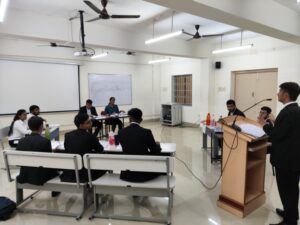
Moving to the second issue, the Counsel argued against a violation of Sections 3 and 3(3) of the Competition Act, contending that there’s no adverse effect on competition. Additional time was granted to address this issue, with reference to Sections 3(3) and 3(4) concerning the horizontal application on employees. The Co-Counsel addressed issues 3, 4, and 5, initiating arguments with the delineation of the relevant market, with emphasis on generative AI as the relevant market.
During questioning, Judges sought clarification on the rule of reason approach, with the Co-Counsel referencing Section 3 and highlighting the relevance of Issue 3 to the Competition Act. The Google v. CCI case was cited to assess dominance, with further reference to Section 19(4) regarding the dominant position of the Enterprise.
The Co-Counsel substantiated arguments with two tests: parallel conduct and certain facts underlying such conduct. The Cement Manufacturers case was cited from EU jurisprudence to justify the justiciability of circumstantial evidence. Due to time constraints, Judges requested a summary of the fifth issue, with Code red situation in annexure 2 referred to.
During questioning, Judges referenced the NSE case, but the Counsel was not aware, having not dealt with that precedent. Following the presentation of arguments, prayers were made contesting CCI’s jurisdiction in trying the case.
Court Hall-III
In the respondent’s argument, Issue 1 primarily addresses the question of whether arbitration falls under the purview of the Competition Act. The counsel points out that Section 33(b) empowers the CCI to temporarily restrain anti-competitive activities. They reference specific sections of the Competition Act, such as Section 3(4) and Section 19(3), to support their argument that arbitration does not validate anti-competitive behavior. Additionally, they cite a Rajasthan case where the court held that arbitration does not negate the Competition Act’s provisions.
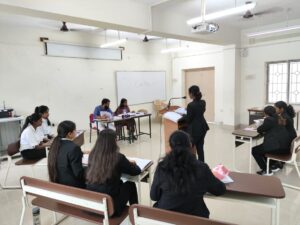
Moving on to Issue 5, the respondent argues about the abuse of dominant position, highlighting the criteria outlined in the Competition Act, 2002. They emphasize that any enterprise using its market position exclusively could be considered to be abusing its dominance, referencing relevant sections of both the Competition Act and the Indian Contract Act. The counsel seeks to elucidate how the actions of Sherlock Inc., in aggressively poaching employees from competitors, could potentially violate Section 4 of the Competition Act, known as Cratokrazi.
Furthermore, the respondent delves into the concept of relevant markets and the operation of enterprises within them. They refer to Section 19(5) of the Competition Act, which discusses how enterprises should operate independently within relevant markets, without unduly favoring themselves. The counsel also touches upon the importance of healthy competition for societal growth, emphasizing the need for equal opportunities for all businesses in the market.
Lastly, the respondent mentions the significance of case laws, such as the Denmark case, to support their arguments regarding the prohibition of abuse of dominant position. They stress the importance of ensuring fair competition and equal opportunities for all players in the market, ultimately advocating for the rejection of any practices that may undermine these principles. Overall, the respondent’s argument aims to establish the necessity of regulating market behavior to foster healthy competition and ensure fairness for all stakeholders.
Court Hall-V
In Court Hall 105, the proceedings commenced promptly at 10:18 AM, with the appellants, T-19, taking the floor to introduce themselves and present the case’s facts. The focal point of the case revolves around the release of a new AI chatbot, raising five central issues for consideration. Initially, the appellants tackled the Issue of Jurisdiction, arguing that the Competition Commission of India (CCI) possesses jurisdiction over the matter, citing the exclusivity of arbitration and competition jurisdictions.
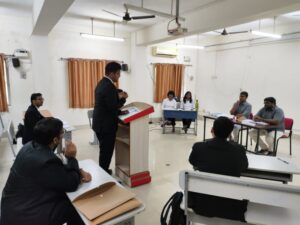
Subsequently, Speaker 2 delved into Issues 3 and 5. Issue 3 centered on abuse of powers, while Issue 5 continued the arguments from Speaker 1’s presentation. The speaker argued that dominance alone does not constitute anti-competitive behavior and contended that voluntary employment in the appellant company does not signify a dominant position. Discussions on hiring and poaching practices ensued, referencing American cases to highlight the necessary elements for anti-competitive practices. The SCI case of Gujarat Bottle was cited to support the appellants’ stance against poaching.
Throughout the session, judges posed queries to clarify the merits of the arguments, prompting an additional minute request for ongoing issues. The judges’ queries were addressed, with reference to specific sections of the moot proposition.
For the Respondents side, Counsel 1 contended that the Competition Commission of India (CCI) erred in assuming jurisdiction, citing Section 18 of the Competition Act and emphasizing the absence of anti-competitive practices in the case. Citing relevant case law, Counsel argued that the Non-Disclosure Agreement (NDA) binding for up to four years post-employment termination indicated no anti-competitive behavior by Poirot AI, thus negating CCI’s jurisdiction.
During rebuttals, which commenced at 11:41 AM, concise arguments were made countering each other’s claims with brevity and clarity. Arguments centered on the interpretation of trade secrets, propriety information, and the natural progression of employees finding new jobs post-termination.
Court Hall-VI
The Appellant established their jurisdiction and provided a brief overview of the facts. Counsel 1 addressed the first three issues, while Counsel 2 handled the remaining ones. The issue of jurisdiction was thoroughly discussed, with reference to the moot proposition and assistance from the compendium. Emphasis was placed on the impartiality of arbitration.
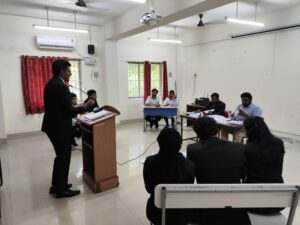
During the proceedings, the Judge inquired about the jurisdiction of the CCI in the case, which was supported by relevant case law provided by the Counsel. Furthermore, the distinction between Right in rem and right in personam was explored. Counsel 2 for the Appellant elucidated on the presence of dominant position and the case of anti-competitive agreement, citing Section 3 as applicable. Additionally, they delineated how the services provided by both AI inventions differed.
The Counsel for the Respondents endeavored to establish why there was no jurisdiction of the CCI in the case, highlighting the CCI v. Sale case in relation to criminal jurisprudence and presenting arguments for a prima facie case. The judges queried the Counsel about adequate notice. Subsequently, the issue of the absence of an anti-competitive agreement between the parties was addressed.
Court Hall-VIII
During the proceedings, the Judge inquired about the involvement of both parties, prompting Counsel to reference Section 19 of the Contract Act for explanation. Additionally, when questioned about the absence of arbitration, Counsel explained that the parties had agreed to bring the matter before the CCI. When asked about circumstantial evidence, Counsel 2 stated that none existed. Further inquiry regarding the consideration of the Internal Investigating Committee’s report as evidence led Counsel 1 to cite relevant cases where such reports were deemed admissible.
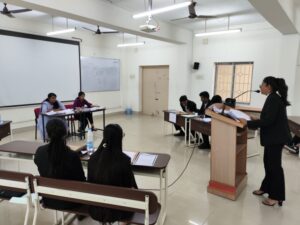
The Judge raised a query regarding the timing of the allegations, given that the AI was developed in 2019. Counsel clarified that while concepts were developed in 2019, the AI itself was not finalized until later. Subsequently, when the validity of arguments under the Contract Act was questioned, Counsel 2 defended its validity, referencing Section 27.
In another query, the Judge sought clarification on the constituent rights of employees, to which Counsel 2 highlighted Articles 19 and 21. Finally, Counsel 2 requested the dismissal of the case, concluding their arguments.
Court Hall-IX
The Judges entered the Hall, followed by instructions, and the proceedings officially commenced. Counsel 1 of the Appellant began briefing the case, concluding with intermittent reference to the moot proposition. Counsel 1 claimed that the Competition Commission of India (CCI) was justified in assuming jurisdiction over the case arising from Civil Appeal No. 007 of 2023, citing the Employee Employment Agreement (EEA) mandating arbitration as the dispute resolution mechanism. However, Judges urged Counsel 1 to avoid casual language and substantiate claims with evidence.
Counsel 1 sought permission to consult the bare act, which was granted. Judges advised Counsel 1 against jumping to conclusions and emphasized the need to justify legal opinions. Further, Counsel 1 accused Sherlock Inc. of poaching, prompting Judges to request justification and careful word choice. Counsel 1 referenced a Supreme Court case to support their argument. The statement of jurisdiction was reiterated by both Judges and participants.
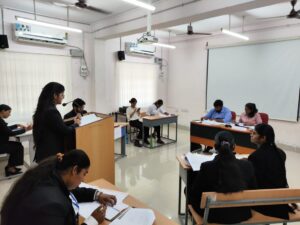
Counsel 2 of the Appellant assumed control, referencing Section 3 of the Competition Act and citing the case of C Shanmugam and Manish Gandhi vs. Reliance Jio Infocomm Ltd, DoT, TRAI, and BSNL. Counsel 1 of the Respondent began their argument, highlighting mistakes in Issue no. 5 of the Respondent’s Memorial. They contested CCI’s jurisdiction assumption. Counsel 2 of the Respondent requested a minute to consult the bare act, following which Judges queried the Respondent on the ingredients for a prima facie case.
Court Hall-X
The Respondent discusses Issue 2 and proposes reforms to Section 2 of CCC. Upon inquiry from the Judges, the Respondent is prompted to provide a factual context and clarify the point being argued. The Judges seek clarification on how poaching is occurring, prompting the Respondent to refer to paragraph 23 of the Proposition. Furthermore, the Respondent asserts that the cooling period of one year has not been adhered to.
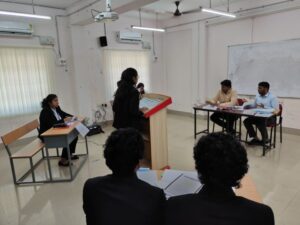
The Appellant assumes control and is reminded by the Judges to address the Respondent’s questions rather than introducing new ones. The Appellant refers to paragraph 4 of the Moot Proposition.
Subsequently, the Respondent resumes their argument, reiterating claims of poaching and non-compliance with the one-year cooling period. The proceedings conclude, with the Judges offering suggestions to enhance clarity and understanding, emphasizing the importance of not rushing through arguments and suggesting a slower pace of delivery. They stress the need to ensure that every point is explained thoroughly to aid comprehension, considering the Judges’ unfamiliarity with the case.
Court Hall-XI
The Respondent’s Counsel, addressing the court, emphasized the contractual nature of the dispute governed by Article 9 of the Employment Engagement Agreement (EEA), which mandates arbitration as the dispute resolution mechanism. While acknowledging the validity of arbitration, broader concerns were raised by the Judge regarding potential violations of Section 27 of the Indian Contract Act. In response, the Counsel assured adherence to the terms of the EEA, asserting that PiratAI’s actions were within legal boundaries but expressed readiness to address any concerns raised within the purview of the law.
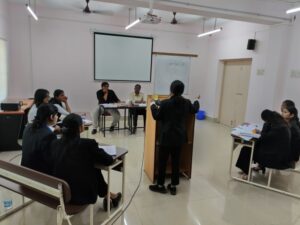
Moving on to allegations of cartel formation involving Sherlock and DupinAI, the Respondent’s Counsel asserted the existence of evidence suggesting the establishment of a cartel, indicating investigations conducted by relevant authorities. Moreover, in response to queries regarding the audit of trade secrets, the Counsel acknowledged the importance of impartiality and transparency, signaling openness to involving a third party for future audits. This stance underscores PiratAI’s commitment to maintaining ethical standards despite internal audits.
Concerning employee poaching and trade secret protection, the Counsel underscored PiratAI’s commitment to safeguarding employee rights and confidential information. While acknowledging the importance of employment opportunities, the Counsel highlighted the paramount importance of upholding the integrity of the company and the confidentiality of sensitive information. This emphasis on ethical conduct and protection of proprietary information aligns with PiratAI’s commitment to legal and ethical standards. In conclusion, the Counsel respectfully urged the court to impartially consider the arguments presented and uphold principles of fairness and justice.
Court Hall-XII
Counsel 1 commenced by seeking permission to present arguments, first providing a briefing on the facts of the case and subsequently outlining the submissions. Clear jurisdictional arguments were made, with references to Section 47 of the Contract Act, Article 19 of the Constitution of India, and the IP Act. When questioned by the Judge about jurisdiction, Counsel 1 adeptly referred to relevant case laws to support their stance.
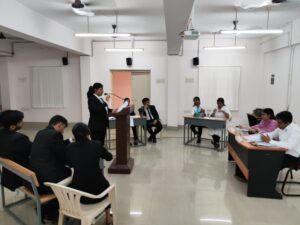
Further queries from the Judge regarding the respondent’s awareness of Counsel 1’s arguments were addressed by referring to a paragraph in the preposition. Counsel 1 also explained the applicability of Section 49 of the Contract Act and elucidated on the usage of Section 3(1). Following Counsel 1’s presentation, Counsel 2 sought permission to present arguments. They meticulously highlighted the loopholes in the case concerning the application of certain provisions, adding depth to the discussion.
12:00 AM | Preliminary Round-II| UG and PG Block
Court Hall-IV
In addressing the first issue concerning the time period of the Ambient Commission, it has been established that the commission operates within a timeframe of two years. Moving on to the intricacies of employer-employee relationships within the realm of competition law, the focus shifts to Section 19(3) and its correlation with Section 27, where the commission is empowered to direct enterprises to adhere to its directives, including the payment of expenses. However, concerns arise regarding potential violations of Sections 33 and 34 during investigative procedures, as the commission may exercise control over alleged offending parties until investigations are concluded.
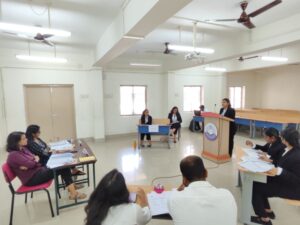
This raises questions about the balance between investigative powers and due process. Furthermore, a critical argument surfaces regarding the use of AI in hiring practices, positing that its implementation may inadvertently lead to anti-competitive biases by limiting the entry of new players into the market. Moreover, jurisdictional issues are brought to light, particularly regarding the jurisdiction of the commission over cases involving arbitration mandates, as seen in the scenario arising from Civil Appeal No. 007 of 2023.
This prompts a reassessment of the commission’s scope and authority in such matters. Additionally, scrutiny is directed towards the treatment of abusive dominant positions as outlined in Section 4 of the Competition Act, with emphasis on the commission’s duty to conduct thorough market assessments before intervening in commercial disputes. In light of these discussions, it becomes imperative to consider potential amendments to relevant sections of the Act to address presumptive anti-competitive conduct and ensure a fair and competitive marketplace.
Court Hall-VI
During the proceedings, Counsel outlined the duties of the Competition Commission of India (CCI) and emphasized the exclusive right of the parties in the arbitration agreement, supported by references from relevant books like SM Dugle. The violation of Section 3(3) of the Competition Act by vertical agreements was discussed, along with establishing AI as the relevant market in the case, highlighting its adaptability to user needs. The hindrance created in the development of AI technology and the prevention of new entrants into the market were underscored.
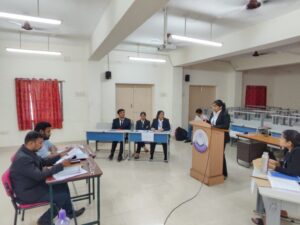
Regarding public interest, Counsel asserted that there were no arguments presented by the Respondent regarding anti-competitive behavior. The significance of the Arbitration Act and the importance of a sole arbitrator were also emphasized. In response to queries from the judges regarding fairness towards employee opportunities, Counsel explained why it was not considered anti-competitive, stressing the need for legitimate conduct by employees.
Moreover, various circumstantial evidence was highlighted, including a significant number of layoffs, indicating concerted actions necessary for cartelization. Counsel reiterated the importance of ensuring legitimate conduct and highlighted the need for a fair and competitive market environment.
Court Hall-VII
Appellant Counsel 1 commenced by presenting a 3-fold argument emphasizing the jurisdiction of the Competition Commission of India (CCI) in the case. They highlighted the expiration of the Employment Engagement Agreement (EEA) cooling period and argued that arbitration cannot exclusively address the nature of the dispute, citing precedents like CCI v. Mscdc Ltd. The Counsel contended that Poirot AI’s actions violated competition laws, particularly Section 3(4), by engaging in anti-competitive agreements, and questioned the reasonableness of the EEA’s one-year cooling period. However, the Judges questioned the merits of this argument, challenging the authority of a lesser cooling period.
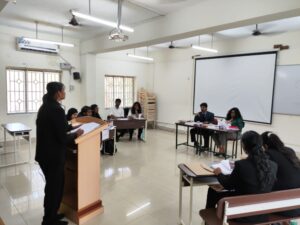
In the subsequent submissions, Counsel 2 further elaborated on Poirot AI’s alleged dominance in the AI market and its purported anti-competitive practices. They argued that Poirot’s actions restricted competition, violated employees’ rights, and contravened various sections of the Competition Act. The Counsel also addressed the alleged joint venture between Sherlock and DupinAI, contending that it was more akin to a cartel formation. However, Judges raised doubts regarding the distinction between joint ventures and cartels, challenging the Counsel’s assertions.
On the Respondent’s side, Counsel 1 emphasized the primacy of arbitration in resolving the dispute, citing the provisions of the Arbitration and Conciliation Act. They argued against CCC’s assumption of jurisdiction and defended Poirot AI against allegations of anti-competitive behavior. Counsel 2 further refuted claims of trade secret misappropriation by Sherlock and DupinAI, while highlighting Sherlock’s dominance in the market. However, Judges scrutinized the evidence presented and questioned the validity of the Respondent’s arguments. Overall, both sides presented detailed arguments supported by legal precedents and case law, engaging in a robust legal discourse before the court.
Court Hall-VIII
Counsel 1 for the respondent presented arguments centered around circumstantial evidence, citing relevant case law to support their stance. They emphasized the importance of considering circumstantial evidence in adjudicating the case. Respondent Counsel 2 (R2) highlighted that the moot proposition encompasses both generative and traditional chatbot AI, implying that the case should be viewed in a broader context. Referring to Section 4(2) of the Competition Act, they asserted that their client did not hold a dominant position in the market.
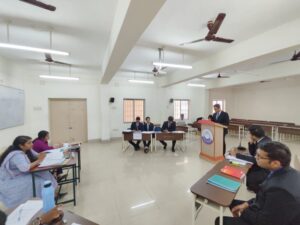
Continuing their argument, R2 acknowledged the judges’ skepticism regarding their client’s lack of dominance but proceeded to assert that even if their client were in a dominant position, they did not abuse it. R2 contended that their client did not violate Sections 3 and 4 of the Competition Act, challenging the appellants’ allegations.
R2 further argued that the appellants faced market challenges due to their own dominant position, suggesting that they may have violated Sections 3 and 4 of the Competition Act. Finally, R2 asserted that the Competition Commission of India (CCI) had no jurisdiction over the case, emphasizing legal procedural aspects. In response, Counsel 1 for the appellants (C1) countered by highlighting the pecuniary nature of the market, implying that the respondents’ arguments failed to consider critical economic factors.
Court Hall-IX
The proceedings commenced at 12:09, with the Appellants addressing Issues 3 and 5. The preposition was briefed by the Appellant, following which the Judges pointed out an error in the mention of the Respondent. The Appellant clarified the mistake and explained the necessary corrections made. They elaborated on the distinction between Rights in Persona and Rights in Rem, citing specific references such as Para 13, 3rd line, and Section 53 (T) of the Competition Act for the Statement of Jurisdiction. Additionally, Para 36 of the moot preposition was referenced.
Moving on to the second issue, the Appellant referred to Section 3 of the Competition Act. Upon questioning from the Judges regarding the grounds for claiming adverse effects on competition, the Appellant cited Para 29 and relevant case laws such as Neha Gupta vs Tata Motors Ltd. and Google vs CCI. The Judges inquired about the regulation of the market, to which Section 3(5) was referenced, indicating a lack of protection. The case of Maruti v. State of Karnataka was also cited.
Further discussions revolved around the nature of Section 19 and the volatility of the market, with references to employment policies. Interestingly, the argument put forth by the Appellant seemed contradictory, leading the Judges to acknowledge a strong point of argument for the Respondent. Notably, the Appellant did not claim aggressive poaching during their presentation.
Court Hall-XII
At 12:09 PM, Counsel for the appellants sought permission to present their argument before the court. Counsel 1 began by addressing the issue of jurisdiction, citing relevant case laws to support their argument that the arbitration clause in the contract is void ab initio. Referring to Section 27 of the Contract Act, C1 argued that arbitration is prima facie void and provided case precedents to substantiate their position.
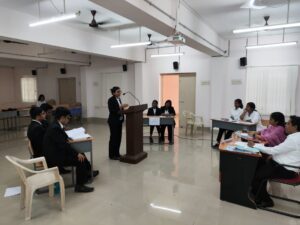
Expanding on their argument, C1 highlighted how the respondent’s actions were impacting the traditional market. When questioned by the judge about the distinction between traditional and generative AI, C1 provided a clear explanation, demonstrating their understanding of the subject matter.
Subsequently, Counsel 2 approached the bench to address the respondent’s market approach. When asked about the relevant market, C2 clarified that it encompasses both generative and traditional AI, rather than search engines, and elaborated on the differences between them to ensure a comprehensive understanding by the court.
RESULTS ARE OUT!
The teams that are going to Quarter Finals are-
T-03
T-04
T-07
T-09
T-11
T-16
T-22
T-23
4:00 PM | Quater-Final Rounds | UG Block
Court Hall-I
The quarter-finals convened in Court Hall 1 around 4:10 pm, presided over by Mr. Niranjan R and Mr. Saai Sudarshan S. Before proceedings commenced, the judges issued instructions, emphasizing the avoidance of unnecessary gestures such as standing or taking oaths during the prayer. As the rounds began, the first speaker for the Appellants faced a volley of questions, notably regarding the unusual scenario of the Competition Commission appealing its own order, to which the counsel expressed a lack of clarity. Subsequently, they were probed on who initiated contact with the Competition Commission and on what legal basis, prompting a reference to pertinent sections in the Competition Act.
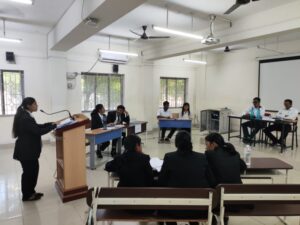
Expounding on the jurisdiction of the Competition Commission, the Speaker delved into Section 19(3) of the Act, arguing a horizontal effect on the market due to Section 3. The judges sought clarification on whether the Act defined the market, leading to a deep dive into subsections (5), (6), and (7) of Section 19 to illustrate their relevance to the case’s particulars. Drawing attention to the memorandum, the Speaker highlighted restrictive employment covenants and cited legal precedents such as the Pepsi Foods Ltd. vs Bharat Coca-Cola Holdings Pvt. Ltd. case. Subsequently, Speaker 2 tackled issues 3, 4, and 5, guided by the judges through relevant clauses under Section 4 of the Act and engaging in discussions on the nuanced definition of the market, particularly exploring the concept of a ‘relevant geographical market’.
Transitioning to the Respondents’ arguments, Speaker 1 commenced by laying out the pertinent facts, particularly focusing on the issue of the case’s maintainability. Arguments were crafted against the jurisdiction of the Competition Commission, centering on the presence of an arbitration clause and the principle of right in persona. However, the bench challenged these assertions, invoking the Vidya Drolia case to contest the counsel’s stance. Additionally, the judges underscored the utilization of Sections 60 and 61 of the Act, signaling a meticulous and comprehensive exploration of the legal intricacies at play.
Moving forward, the judge raised the question of whether Section 8 of the Arbitration and Conciliation Act would impact the case’s maintainability. The counsel emphasized the significance of the arbitration clause in the agreement, citing cases like Smt. Rukmanibai Gupta vs Collector Jabalpur And Ors., and Bayer Corporation to support their argument. Additionally, they asserted that Sections 3(3), 3(4), and 3(1) of the Competition Act were not applicable to the present case. Subsequently, the counsel addressed Issue 3 and elucidated on the interpretation of being in a ‘dominant position’.
The second speaker then took the floor to tackle Issues 4 and 5, referencing relevant cases despite the judges’ observation that these cases were not yet decided by the Supreme Court. They delved into Section 27 of the Indian Contract Act, the definition of cartel, and the circumstances leading to cartelization, supported by Section 2(c) of the act. In response to the judges’ inquiry about how the process of ‘poaching’ in the case amounted to cartelization, the speaker provided insights. Finally, Speaker 2 concluded with the Prayer.
Court Hall-II
The Quarter-finals in Court Hall II commenced at 4:08 PM, marked by a palpable sense of anticipation. Led by the appellants, Counsel 1 embarked on a meticulously crafted argument aimed at establishing the jurisdiction of the Competition Commission of India (CCI). With precision, Counsel 1 navigated through legal precedents, citing cases such as Dhulak Trading Co. to substantiate the contention that CCI’s intervention was warranted. The validity of the arbitration clause was vehemently challenged, invoking Section 60 and 61 of the Competition Act to bolster the argument that competition matters inherently transcend individual arbitration proceedings. The counsel’s articulation of the complex legal terrain set the stage for a robust exchange of ideas.
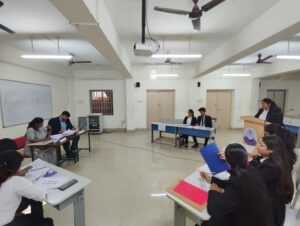
Following Counsel 1’s comprehensive presentation, Counsel 2 for the appellants took center stage, unraveling the intricacies of non-compete clauses and the alleged dominance of Poirot AI in the market. Drawing upon a rich tapestry of legal principles and case references, Counsel 2 dissected the essence of anti-competitive behavior, emphasizing the need for a nuanced understanding of market dynamics. The argument traversed through the realm of economic analysis, shedding light on the evolving landscape of competition law in the context of novel industries such as artificial intelligence.
As the appellants concluded their submissions, the courtroom atmosphere crackled with anticipation as Counsel 1 for the respondents stepped forward to counter the arguments put forth. With measured precision, Counsel 1 dismantled the appellants’ assertions, challenging the very foundation of CCI’s jurisdiction. The counsel artfully articulated the private nature of the dispute between Poirot and its terminated employees, contending that CCC’s purview extended only to matters of public interest. This deft legal maneuvering set the stage for a compelling narrative, exploring the nuances of competition law within the framework of individual rights.
Undeterred by the appellants’ formidable arguments, Counsel 2 for the respondents launched into a robust defense, unraveling the complexities of dominance in the market and refuting claims of cartelization. With a keen eye for detail, the counsel dissected the intricacies of market dynamics, challenging the notion of dominance solely based on market share. Drawing upon a rich tapestry of legal precedents and industry insights, Counsel 2 navigated through the labyrinth of competition law, skillfully dismantling the appellants’ contentions and offering a compelling counter-narrative.
As the proceedings drew to a close, the courtroom reverberated with the echoes of impassioned arguments and rigorous debate. The exchange between the counsels and the judges underscored the inherent complexity of competition law, leaving the audience captivated by the intellectual rigor displayed. With fervent prayers from both parties, the stage was set for the judges to deliberate on the intricate legal and factual issues presented, marking a pivotal moment in the quarter-final proceedings.
Court Hall-III
The courtroom session began with the judge asking the lawyers for the appellants, or those appealing the decision, to explain the facts of the case and why they went to the Competition Commission of India (CCI). However, the lawyers faced challenges in articulating their arguments, particularly regarding arbitration and jurisdiction. The judge pressed them on whether CCI was the appropriate venue for their case, given that it seemed to involve contractual issues.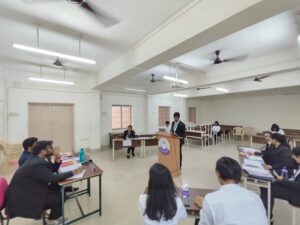
As the discussion progressed, the lawyers for the appellants attempted to clarify their position, emphasizing the public interest and the impact on the market as reasons for involving CCI. Despite their efforts, the judge remained skeptical and questioned the validity of their approach. The lawyers were reminded of the importance of fully understanding the jurisdictional aspects of the case before presenting their arguments.
Switching to the respondents’ side, their lawyers sought to defend against the appeal by explaining their company’s actions and justifying their stance. They argued that their company had not violated any laws and had acted within the bounds of fairness and competition. However, the judge raised probing questions about the fairness of their actions and whether they were truly in compliance with legal standards.
Throughout the proceedings, both sides faced scrutiny from the judge, who sought clear and convincing explanations for their positions. The complexity of the legal issues, particularly regarding arbitration clauses and competition law, made it challenging for the lawyers to provide satisfactory answers. Despite these challenges, the courtroom discussion underscored the importance of legal clarity and fairness in resolving disputes.
In conclusion, the courtroom session highlighted the intricacies of the case and the need for a thorough understanding of legal principles. Both sides grappled with explaining their actions within the framework of arbitration and competition law, while the judge scrutinized their arguments to ensure adherence to legal standards. The proceedings reflected the complexities inherent in navigating legal disputes and underscored the importance of rigorous legal analysis in reaching a just resolution.
Court Hall-IV
The Appellant initiated their arguments by elucidating the jurisprudential essence underlying the case and firmly asserting the jurisdiction of the Competition Commission of India (CCI). They emphasized the pivotal role of the CCI in matters concerning competition law and referred to legal precedents, including Page 31 of the compendium, to bolster their stance.
The Appellant underscored the importance of actions in rem, particularly when issues of substantial public interest are at stake, citing the Associate Builders case as an illustrative example. Additionally, they pointed out the significance of considering the general context, especially in the rapidly evolving and dynamic generative AI market, where impediments to new entrants could hamper technological progress.
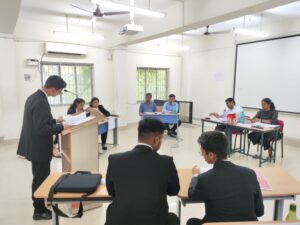
In challenging the Respondent’s alleged abuse of dominance, the Appellant meticulously analyzed relevant market dynamics, enterprise dominance, and instances of abuse, supported by legal provisions such as Section 19(4) of the CCI Act. They highlighted the unique characteristics of the generative AI market, such as high technical barriers and rapid innovation, to refute claims of cartelization and aggressive poaching. Furthermore, the Appellant argued that Sherlock Inc. did not possess undue dominance or engage in anti-competitive behavior, citing legal precedents and provisions under the CCI Act.
Moving forward, the Respondent presented a comprehensive rebuttal by delineating the distinction between rights in rem and rights in personam, thereby positioning the dispute within the ambit of the latter category. They referenced legal precedents, such as the SBI case, to support their contention that certain disputes, including those involving non-compete clauses, are non-arbitrable. Additionally, the Respondent highlighted the sensitive nature of proprietary information and the necessity to protect key managerial positions, invoking provisions of the Indian Contract Act.
Addressing the alleged adverse effects on competition, the Respondent articulated a nuanced perspective, asserting that stability within the industry was maintained while encouraging innovation. They delved into the differentiation between traditional and generative AI markets, emphasizing consumer satisfaction and relevant market delineation as per Section 19(7) of the act. Drawing analogies from European companies, the Respondent illustrated Sherlock’s market dominance and consumer reliance, underscoring the unique market dynamics at play.
Overall, the Respondent’s arguments revolved around practical considerations and consumer preferences, positing their case as distinct from the Appellant’s contentions and providing a detailed rationale for their stance.
Quater Finals results are out!
Teams that are going to Semi-Finals are-
- NLSIU, Bangalore
- Nirma University
- MNLU, Mumbai
- MNLU, Nagpur
24th March 2024 (Day-3)
10:00 PM | Semi-Final Rounds | UG Block
Court Hall-I
The judges greeted the participants and initiated the proceedings by providing an overview of the case facts. They highlighted the key issues to be addressed during the session, emphasizing the bifurcation of the arguments between the appellant and respondent sides.
The appellant’s counsel began by asserting the jurisdiction of the Competition Commission of India (CCI) in assuming authority over the case. They cited the Client Associates case and argued that the dispute involved anti-competitive conduct, thus falling within the purview of the CCI. The judges questioned whether the matter was merely a private employee dispute, to which the counsel emphasized the public interest aspect due to restraints imposed by Poirot on skilled employees. The validity of arbitration was also raised, citing precedents like the HCC Ltd. case to highlight potential biases in unilateral appointments.
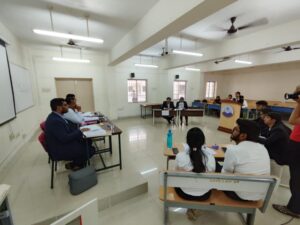
Moving on, the appellant’s counsel addressed Poirot AI’s alleged anti-competitive practices under Sections 3(3), 3(4), and 3(1) of the Competition Act. They argued that the enforcement of Exclusive Employment Agreements (EEA) violated Section 3(3), while judges questioned the applicability of these sections and the establishment of relevant markets. The counsel contended that Poirot AI held dominance in the AI market, leading to abuse of its position, but faced skepticism from the judges regarding the definition of relevant markets and the impact on competition.The respondent’s counsel challenged the jurisdiction of the CCI, arguing procedural errors and questioning whether the matter fell under right in rem or right in personam.
They disputed allegations of anti-competitive conduct by Poirot AI, emphasizing the reasonableness of Exclusive Employment Agreements (EEA) and advocating for arbitration. The judges probed the nature of the dispute and the application of competition law, highlighting concerns over employee rights and market access denial.Continuing the respondent’s argument, the counsel contested Poirot AI’s dominance and alleged cartelization between Sherlock and Dupin AI. They refuted claims of trade secret misappropriation and violation of Section 4(2)(e), emphasizing the absence of market dominance and challenging the definition of relevant markets. The judges sought clarification on the evidence presented and the applicability of competition law in the context of employee hiring practices.
The court session concluded with prayers from both sides, marking the end of the arguments presented. The judges deliberated on the complex legal issues raised during the proceedings, aiming to reach a fair and just decision based on the merits of the case.
Court Hall-II
The appellant’s counsel began by addressing the issue of arbitration, arguing that the Competition Commission of India (CCI) was justified in assuming jurisdiction due to the nature of the dispute, which involved substantial public interest matters. They emphasized that administrative law within the competition law framework allows for CCI’s intervention, especially when rights in rem are at stake. The counsel cited relevant cases such as Natraj and Central Warehouse to support their argument, highlighting Section 5 of the Arbitration Act as a non-obstante clause that grants exclusive authority regarding arbitrability.
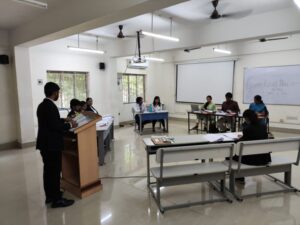
Moving on, the appellant’s counsel discussed the existence of a dominant player in the market and its implications. They examined the impact on scientific development, citing cases like Perkins (2019) to underscore the significance of restricted covenants and trade secrets protection. The counsel delved into Section 3 of the Competition Act, emphasizing the need for strong evidence to establish anti-competitive conduct, including cartel formation. They further argued violations of Section 4 regarding abuse of dominant position, stressing the importance of defining relevant geographical and product markets to determine liability.
The appellant’s counsel then explored the concept of market definition, advocating for a narrower approach to assess dominance accurately. They cited European Commission precedents and emphasized the essential role of market share in determining dominance. Sourabh Singh’s case was referenced to illustrate the coercive nature of dispute resolution methods. The counsel refuted claims of employee poaching, asserting the anti-competitive nature of certain covenants, while acknowledging the importance of considering employees’ skills in the context of the dispute.
Moving forward, the respondent’s counsel focused on the contractual obligations and the jurisdiction of the Competition Commission, arguing that matters related to arbitration fall outside its purview. They cited Section 16 of the Arbitration and Conciliation Act and Supreme Court precedents to support their position. Additionally, they emphasized the protection of trade secrets and restrictive covenants under Section 27 of the Indian Contract Act, referencing cases like Nilajan Golika and VN Desh Pandey to establish the reasonableness of such provisions.
Furthermore, the respondent’s counsel disputed the appellant’s claims regarding dominance and anti-competitive conduct. They highlighted the absence of explicit agreements and emphasized the applicability of Section 5 and Section 4(2)(e) of the Competition Act. The counsel argued against the presumption of poaching by Sherlock Inc., pointing out adversarial effects in the market and advocating for a more nuanced understanding of relevant markets. Finally, they challenged the appellant’s assertions regarding employee poaching, asserting that Poirot AI was the primary entity affected by the dispute.
Overall, both parties presented detailed arguments addressing various legal aspects and precedents relevant to the dispute at hand. Their arguments touched upon jurisdictional issues, the definition of relevant markets, the concept of dominance, and the validity of contractual provisions, providing a comprehensive overview of the complexities involved in the case.
Teams that are going to the Finals are-
- NLSIU, Bangalore
- Nirma University
3:00 PM | Final Rounds | Moot Court Hall
Appellant-
The appellant’s argument primarily revolves around the jurisdictional issue, the validity of arbitration, and allegations of anti-competitive behavior. They contend that the Competition Commission of Cratokrazi (CCC) was correct in assuming jurisdiction due to anti-competitive concerns, asserting that the dispute transcends mere private contractual matters. Citing precedent cases like Union of India v. CCI and Sameer Agarwal, they argue that inquiries conducted by the CCC are inherently different from contractual disputes and fall under the purview of competition law. Additionally, they challenge the validity of the Dispute Resolution Agreement (DRA), arguing that unilateral appointment of an arbitrator violates principles of fairness, citing Parken and emphasizing the importance of consensus ad Idum in arbitration proceedings.
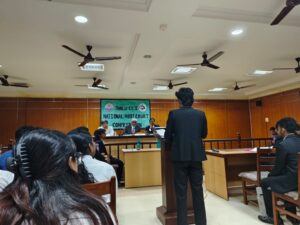
Moving on to the substantive anti-competitive allegations, the appellant elaborates on the applicability of Section 3 of the Competition Act, highlighting the wide ambit of the provision and its relevance in prohibiting vertical and horizontal agreements. Drawing insights from FTC rulings, they underscore the detrimental impact of non-compete clauses on competition and cite relevant provisions of the Sherman Act. Furthermore, they delve into the intricacies of the AI market, drawing parallels between traditional and generative AI and emphasizing the dominance of Poirot AI in the relevant market. They stress the need for delineating the market accurately to establish the alleged anti-competitive behavior effectively.
The appellant further contends that Poirot AI imposed unfair conditions through its executive employment agreements, raising concerns about potential cartelization and trade secret misappropriation involving Sherlock Inc. and Dupin AI. They argue that the restrictive covenants in the agreements hinder market access and innovation, citing legal precedents and market data to support their claims. Additionally, they assert that the employment practices of Sherlock Inc., including aggressive poaching of key employees, violate Section 4 of the Competition Act. Through these arguments, the appellant seeks to establish the anti-competitive nature of Poirot AI’s actions and the necessity for CCC intervention.
Respondent-
The respondent’s primary argument revolves around challenging the jurisdiction of the CCC and contesting the validity of the arbitration agreement. They cite Section 26(5) of the Competition Act, highlighting procedural irregularities in CCC’s proceedings, and assert that the dispute primarily concerns a private employer-employee contract, falling outside the realm of competition law. Drawing on Article 11(6) of the Arbitration Act and legal precedents like Nirajan Golika, they argue for the enforceability of the arbitration agreement and the autonomy of the parties in appointing arbitrators.
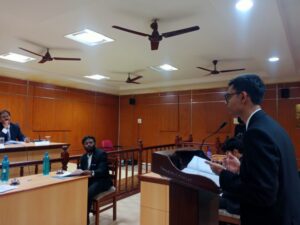
Regarding the substantive allegations of anti-competitive behavior, the respondent refutes claims of Section 3 violations, emphasizing the collaborative nature of the executive employment agreements (EEA) aimed at fostering innovation. They cite cases like Lea v. Pandia to support their contention that the EEA does not restrict competition and argue that there is no evidence of adverse effects on competition or market access. Additionally, they stress the importance of scientific and technological development, asserting that the restrictive covenants in the EEA serve legitimate purposes without hindering competition.
Moving on to the market delineation and cartelization allegations, the respondent challenges the appellant’s characterization of the relevant market and disputes claims of dominance by Poirot AI. They argue that Sherlock Inc. and Dupin AI are not engaged in cartel behavior and refute allegations of trade secret misappropriation. Citing Builders Association and relevant market data, they contend that circumstantial evidence should not be used to establish anti-competitive behavior conclusively. Overall, the respondent seeks to debunk the appellant’s claims and uphold the validity of the EEA while questioning the basis for CCC intervention.
5:30 PM | Valedictory Ceremony | Multi-Purpose Hall
Winners of the 6th TNNLU-CCI National Moot Court Competition, 2024 is-
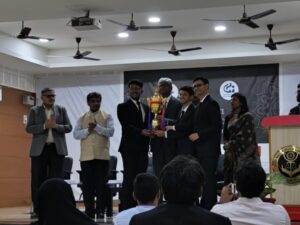
Runners-up-
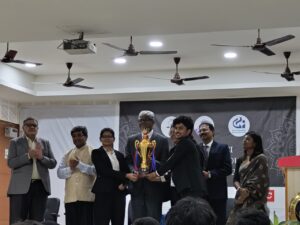
Best Memorial-
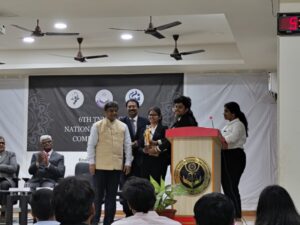
Best Speaker-
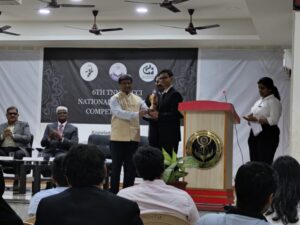
Best Researcher-
